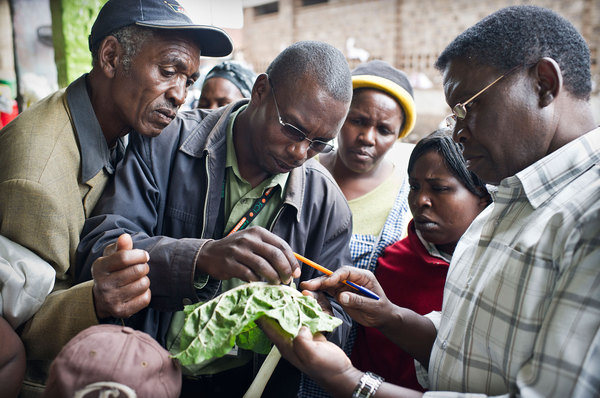Plantwise Plant Clinics in Trinidad and Tobago
Trinidad and Tobago Country Coordinator Shamela Rambadan sent the photo below of a Soursop (Annona muricata) plant brought into a clinic in County Victoria in Trinidad and Tobago by farmer Ramesh Ramnanan last month. The symptoms described included yellowed, distorted leaves and visible insects on the leaves, as seen in the photo. Plant health officer…
Floods in Haiti and India devastate crops
Hurricane Sandy has left fields in the south of Haiti under water, causing crop losses of up to 40%. This follows damage from a drought and the effects of Hurricane Isaac earlier this year. Meanwhile, 9000 miles away in Andhra Pradesh, India, rice farmers are also suffering with their crops waist-deep in floodwater following several…
Bean and Gone – Controlling the Coffee Berry Borer Using Integrated Pest Management
The Coffee Berry Borer, Hypothenemus hampei, is a tiny beetle which is widely considered to be the most damaging pest of coffee plantations in the world. Originating in Africa, it is now found in almost all coffee growing areas in the world as an invasive species, with nearly 160 records from different areas worldwide on…
Experts suggest crops to replace those affected by climate change
Members of the banana family could become a vital food source for millions in developing countries, a new report suggests. The report was written by the Consultative Group on International Agricultural Research (CGIAR) after a request was made by the United Nations Framework Convention on Climate Change (UNFCCC). CGIAR looked at the effect of climate…
Colorado Potato Beetles Left With A Sour Taste As Clover Is Found To Be As Effective As Pesticides
Eggplant or aubergine (Solanum melongena) is a crop often attacked by the Colorado Potato Beetle (Leptinotarsa decemlineata), a major insect pest of plants from the Solanaceae family including potato, tomato and eggplant throughout North America, Europe and Asia. This insect pest is exceptionally destructive to crops and readily develops resistance to a wide variety of…
Plant Pest Interactions: How Soybean Aphids Trick Soybean Plant Defences
Following on from a previous blog on the interactions between soybean plants and soybean pests, new research on soybean (Glycine max) responses to the soybean aphid (Aphis glycines) published in Molecular Plant-Microbe Interactions has revealed some of the complex and fascinating interactions between pests and their plant hosts. This recent research led by Dr Gustavo Macintosh and…
World Food Prize Borlaug Dialogue 2012 highlights the real people affected by global food security issues
By Daniel O’Hara This year’s World Food Prize Borlaug Dialogue concluded on Friday with a breakfast address from the UN Secretary General, Ban Ki-moon, highlighting the importance of food security to global prosperity. The Secretary General’s attendance was an indicator of the importance of food security on the international agenda. He summed up the conference…
Plantwise plant clinic at the Nairobi International Trade Fair
by Kimani Chege and Abigail Rumsey Plant clinics have been running in Kenya since 2010. There are currently 35 clinics throughout Kenya, to which farmers can bring their crops and receive a diagnosis of the pest or disease that is causing them problems. These clinics are organized and run by the Ministry of Agriculture extension…
The Soybean Gene: Scientists Discover the Key to Nematode Resistant Soybeans
Soybean (Glycine max) is an important crop that provides a sustainable source of protein and oil worldwide in countries such as the USA, Brazil, Argentina, India and many African countries, including Nigeria, South Africa and Uganda. The soybean cyst nematode Heterodera glycines is a microscopic roundworm that feeds on the roots of soybean and is…
CABI at the World Food Prize
Today, the 16th October, is World Food Day. In today’s context of rising food insecurity, the timing could not be more fitting. This week global agricultural leaders will gather in Des Moines, Iowa for the World Food Prize & The Borlaug Dialogue. The World Food Prize will be awarded on Thursday 18th October to Dr.…

